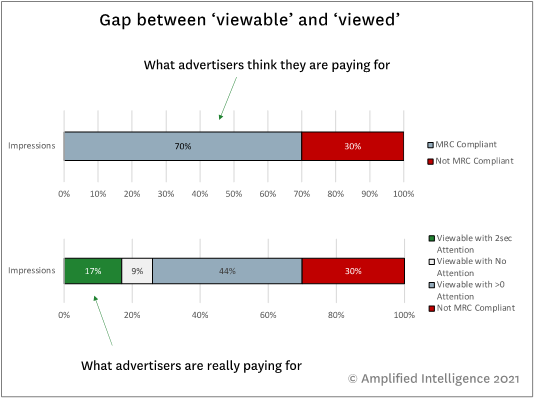Attention data: the gift that keeps on giving

Media Leaders
Mediatel News and Amplified Intelligence promised a revolution and we hope we have delivered.
In the last six months we have articulated the media currency problem, discussed the need for an evolution on invention, talked about the three principal attention applications landing for advertisers and agencies, defined guiding rules around quality attention data, called out to ethical leaders to disrupt responsibly and celebrated the emergence of critical mass in adoption of attention economics.
We certainly have covered a lot, all of which was designed to give you a big-picture view of this fast-evolving category.
But today, in my final paper for the year, I am in the weeds preparing to deliver you a gift – the gift of data.
While this is not normally my remit for this series, I felt compelled to release it so that you can start your 2022 attention conversations with simple but confronting evidence for change.
Views: expectation versus reality
I thought I would share a cut of our data that is nothing short of scary.
It is scary because you are about see the real difference between assumed human-engaged impressions and actual human-engaged impressions.
Put another way, the difference between viewable and viewed, expectations versus reality.
The data below includes a snapshot of 20,000 impressions across four countries including seven popular platforms (a combination of social and general web data).
For background, if you are not aware of what we do at Amplified, we collect attention data by collecting facial footage in real-time from cameras on Mobile, TV and PC.
Our attention data can tell us whether a person is looking directly at an ad (we call this active attention), looking at the mobile screen/second screening but not at the ad directly (passive attention) or not looking at all/not in the room (non-attention).
Here are the facts.
The first part is not new news, at an aggregate level 70% of all impressions are MRC compliant (i.e., 50% pixels and 2 seconds on video, and 50% and 1 second on display). Your expectations are that this 70% delivers human eyeballs to your advertising. Here is the scary part.
Of all impressions you are served:
- 44% are MRC compliant but get insignificant active attention (avg. half second).
- 9% are MRC compliant but get zero attention.
- 17% are both MRC compliant and get active attention for at least 2 seconds.
Thinking about it a different way, of the impressions you have technically paid for (when you buy against MRC standards):
- 63% get insignificant active attention (avg. half second).
- 13% get zero attention.
- 24% get active attention for at least 2 seconds.
This means that around 75% of ads that you have paid for, against the currency you trust, don’t deliver the value you believe them to have.
This expansive gap between viewable and viewed is why our currency, and any models or systems predicated on this data, fail advertisers.

And if you split this down to the platform and format level, things get even more interesting because this gap (or the ratio between viewable and viewed) differs significantly by platform and format.
This tells us:
- Attention and viewability are not the same, if they were the metrics would move together, they don’t.
- Attention and viewability are not the same, if they were the ratio between viewable and viewed would be systematic across platforms and formats, it isn’t.
- Viewability is not a universal metric, because the underlying attentive return differs so drastically by platform and format. It also tells us that you cannot force attention, while ‘viewable’ can be actively avoided.
This means:
- Viewability analytics can’t tell you how much attention has been paid, they can tell you whether an ad has been served.
- Attention models can’t tell you how much attention has been paid if they have little to no human attention data powering them.
Amplified’s newest data scientist comes from a medical AI background. She is learning about media and audience measurement and came to me to check her work concerned for error.
Her words, not mine: “if DHL failed to deliver to a human, you would get your money back. How can this be right?”
Maybe in 2022 we should demand a refund policy on service failures – just saying…
Season’s greetings and take care everyone. I hope to see you all in person in 2022.
Professor Karen Nelson-Field is a media science researcher and founder of Amplified Intelligence. Attention Revolution is a monthly column for Mediatel News in which she explores how brands can activate attention to measure online advertising as well as build a better digital ecosystem.
Media Leaders: Mediatel News’ weekly bulletin with thought leadership and analysis by the industry’s best writers and analysts.
Sign up for free to ensure you stay up to date every Wednesday.



